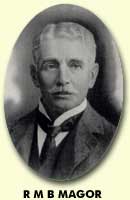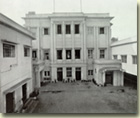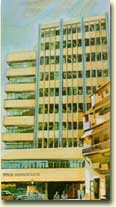|

The history of the Williamson Magor Group dates
back to 1866. In that year, Captain J H Williamson, who was
already involved in the management of tea estates in Assam, met
R B Magor, an assistant with the Great Eastern Hotel in
Calcutta. Their subsequent meetings and association led to the
signing of the First Partnership Deed of the company in 1869.
This was valid for a period of two years.
The agreement was renewed in 1871 and by 1875, its term was increased to five year periods. The company had its first office
premises at 7 China Bazar Street. J H Williamson died in 1898.
George Williamson, who had already withdrawn his capital from
the business in 1879, died in 1903. In 1904, the Partnership
Deed was renewed with R B Magor and J H Williamson's brother -
in - law, Robert Lyell, enjoying an equal share. Williamson Magor & Co. worked
closely with its London partnership,
George Williamson & Co., the firm which a few years earlier
had been started by James Williamson's brother, George.
its term was increased to five year periods. The company had its first office
premises at 7 China Bazar Street. J H Williamson died in 1898.
George Williamson, who had already withdrawn his capital from
the business in 1879, died in 1903. In 1904, the Partnership
Deed was renewed with R B Magor and J H Williamson's brother -
in - law, Robert Lyell, enjoying an equal share. Williamson Magor & Co. worked
closely with its London partnership,
George Williamson & Co., the firm which a few years earlier
had been started by James Williamson's brother, George.
The fortunes of the Williamson Magor Group grew
along with the boom in the Indian tea industry. By the turn of
the century, the company was handling the affairs of 44 tea
estates. The Group also became involved in other businesses,
including coal. Although the Indian tea industry continued to
prosper during the First World War, there was an immediate post
- war slump around 1920. The situation became worse with the
Wall Street crash of 1929 and the ensuing depression. The
production levels of tea far outstripped consumption. George
Williamson, the London end of the partnership and Williamson
Magor, the Indian end of the partnership, consolidated their
position in the tea industry through the twenties and the
thirties.
R B Magor died in 1933. His grandson, Richard
Magor introduced B M Khaitan to the Group. Initially, Briju
Khaitan supplied tea chests and fertilisers to the company and
had become a friend of Pat Williamson, a grandson of J H
Williamson. Williamson Magor & Co. was converted into a Limited Company in 1954. In 1961, a crisis loomed over
the company when B Bajoria, an investor, acquired nearly 25%
stake in the Bishnauth Tea Company, the flagship in the
Williamson Magor Tea Estates. The Khaitan family provided the
money to buy out Bajoria's stake. B M Khaitan was invited to
join the board of the company and later, in the face of stiff
resistance, went on to become Managing Director of the Group.
 The
Guthrie family was the majority shareholder in the McLeod Russel
Group. In 1987, they decided to sell their tea plantations in
India. B M Khaitan negotiated with them and bought out the
estates. This meant the Williamson Group became the largest
private tea producer in the world. George Williamson went on to
acquire and manage tea estates in East Africa. This effort was
pioneered by Richard Magor. In April 2001, George Williamson
& Company, Kolkata and Williamson Magor & Company,
Kolkata mutually decided to separate and work independently. As
a result, George Williamson & Company, London ceased to be
the overseas partners and selling agents for Williamson Magor
& Company, who forged their own links and have now developed
a competent overseas sales network. The
Guthrie family was the majority shareholder in the McLeod Russel
Group. In 1987, they decided to sell their tea plantations in
India. B M Khaitan negotiated with them and bought out the
estates. This meant the Williamson Group became the largest
private tea producer in the world. George Williamson went on to
acquire and manage tea estates in East Africa. This effort was
pioneered by Richard Magor. In April 2001, George Williamson
& Company, Kolkata and Williamson Magor & Company,
Kolkata mutually decided to separate and work independently. As
a result, George Williamson & Company, London ceased to be
the overseas partners and selling agents for Williamson Magor
& Company, who forged their own links and have now developed
a competent overseas sales network.
 The
offices of the Williamson Magor Group were shifted from 7 China
Bazar Street to 4 Mangoe Lane in 1894. Originally known as
Hampton Court, the premises was redeveloped through the mid
1960s. The
offices of the Williamson Magor Group were shifted from 7 China
Bazar Street to 4 Mangoe Lane in 1894. Originally known as
Hampton Court, the premises was redeveloped through the mid
1960s.
Mangoe
Lane tells its own story. It was lined with mango trees on both
sides and presumably took its name from these, though why the
'e', which normally appears only in the plural from 'mangoes',
should have been tagged on is not known.
 The foundation
stone of the splendid new building was laid on
the 24th January, 1966 by
Mrs. O. J. Roy. The foundation
stone of the splendid new building was laid on
the 24th January, 1966 by
Mrs. O. J. Roy.
Rising nine
floors from street level, with an attractive penthouse on top of
the ninth storey, the building, with its somewhat severe
lines, is in keeping with modern trends of architecture.
One of the most
important features of the eighth floor is the very well-equipped
tea tasting room, which is situated on the north side or front
of the building in order to provide optimum working conditions
for the "spitting" staff.
The ten storey block - which stands to the
present day - was officially opened in 1968. This asset proved
to be a valuable investment as a number of floors were let out.

|


